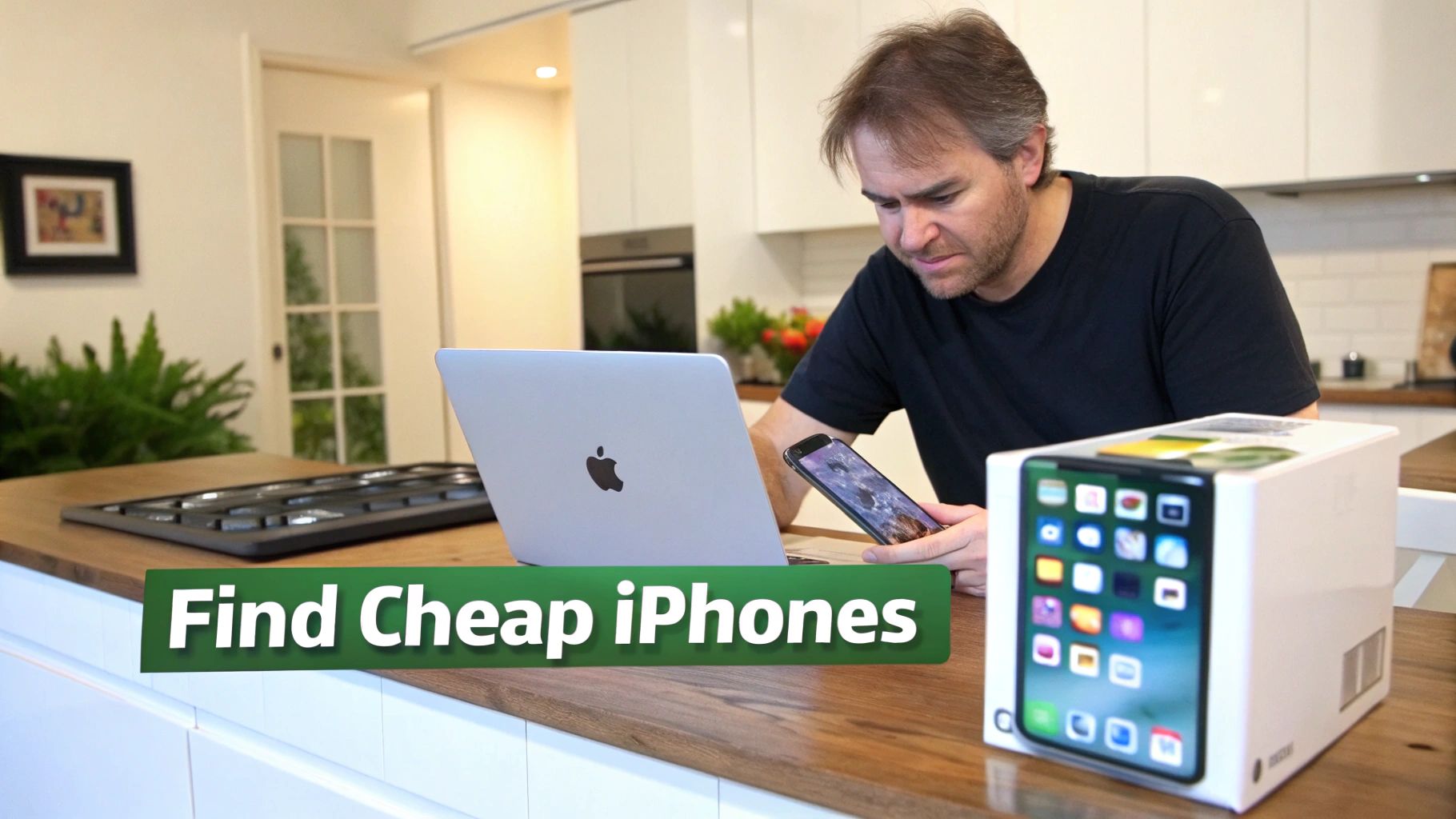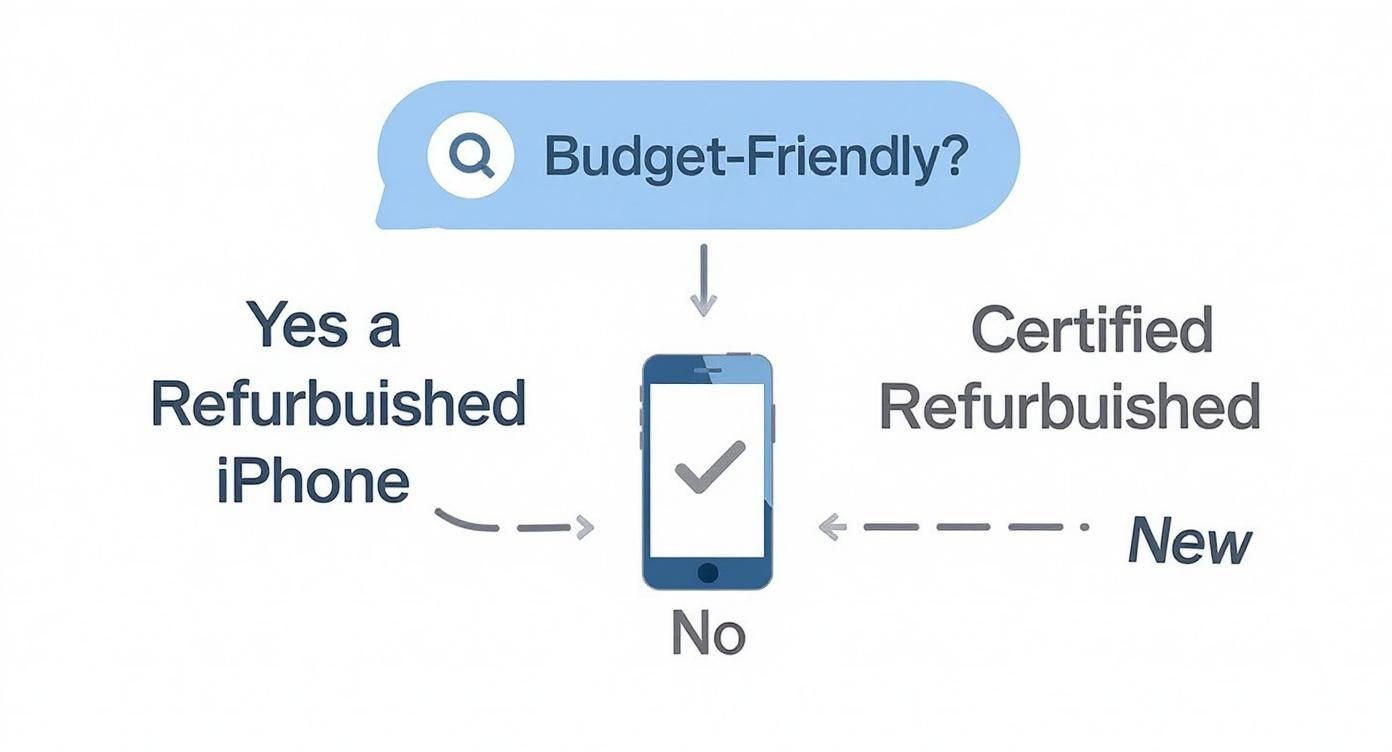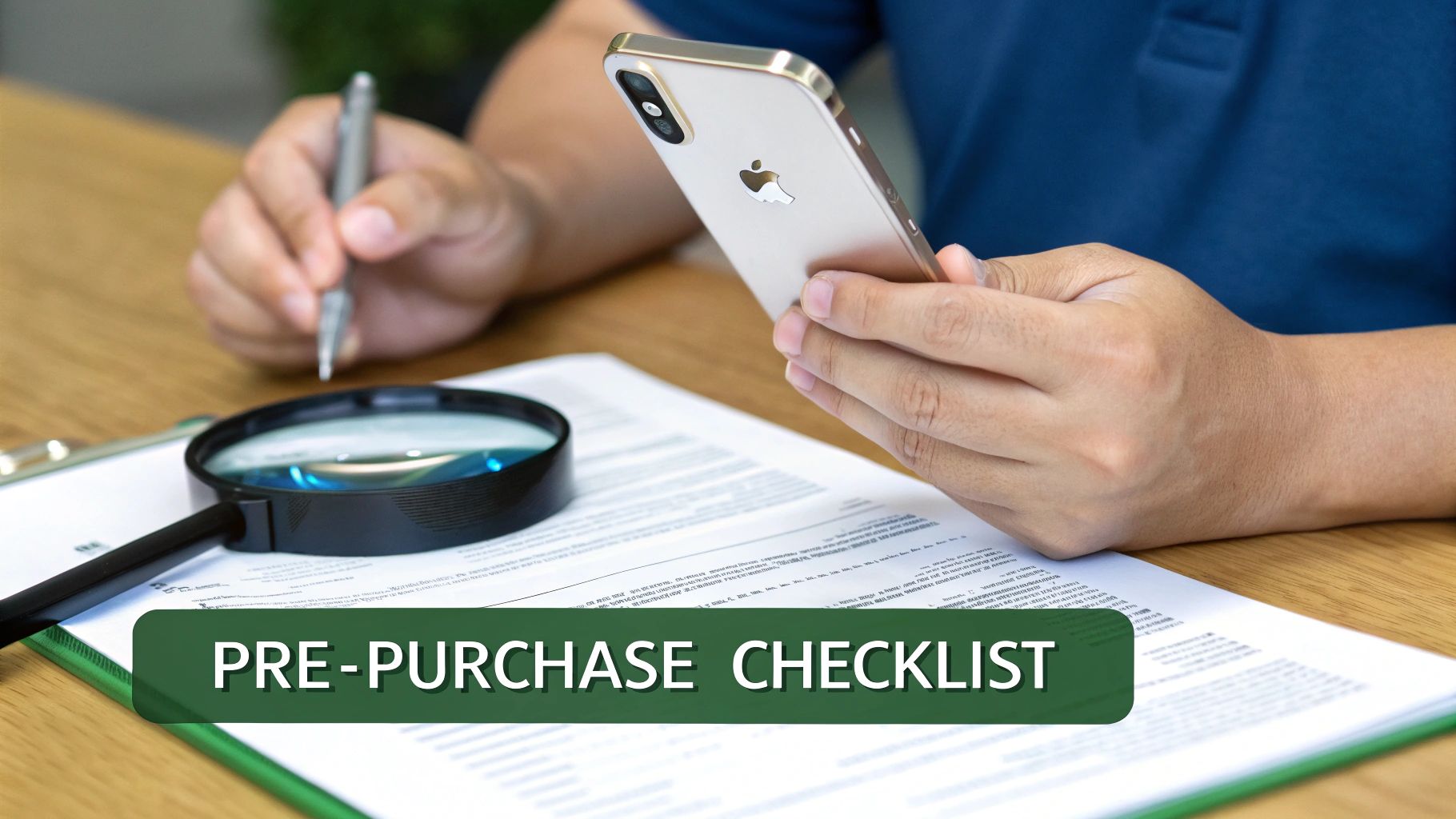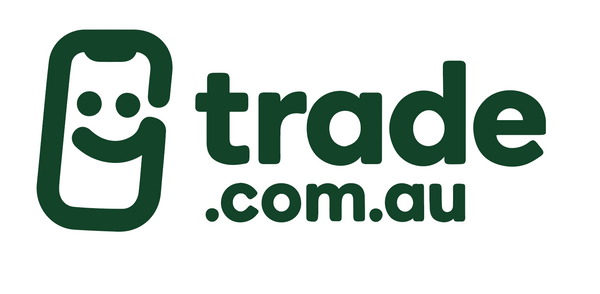
Where to Buy Cheap iPhones in Australia
Scoring a new iPhone without paying the full sticker price is a lot more achievable than most people think. For Aussies who know where to look, the best spots to grab a cheap iPhone range from certified refurbished marketplaces like Trade.com.au and carrier deals to private sales on platforms like Facebook Marketplace. Each one offers a different trade-off between cost, quality, and your peace of mind.
Your Guide to Finding Affordable iPhones in Australia

Hunting down a great deal on an Apple device in Australia can feel like a mission, but knowing where to start is half the battle. Think of this guide as your roadmap to navigating the market and walking away with a brilliant bargain. We’ll cover all the main paths you can take, from the super-secure options to the riskier (but sometimes cheaper) private listings.
As you explore your options, getting a handle on the different online retail platforms is key. Each channel has its own pros and cons, and it’s worth weighing them up carefully before you jump in.
What to Expect in This Guide
To help you make a smart decision, we'll break down the key differences between your main choices. You'll get a clear picture of:
- Certified Refurbished Marketplaces: Places like Trade.com.au hit the sweet spot, offering incredible value and solid security, complete with warranties and thorough device testing.
- Carrier Deals: The major telcos often bundle iPhones with mobile plans. This can lower the upfront cost, but you might find yourself locked into a lengthy contract.
- Private Sales: Sites like Facebook Marketplace can have the lowest prices, but they also carry the highest risk of scams or phones with hidden faults.
The rise of Apple Certified Refurbished devices is a game-changer. It’s not uncommon to see discounts of 15-30% off the new retail price, and they often come with an official warranty. It's a fantastic way to cut costs without making a huge compromise on quality.
To put that into perspective, let's look at a real-world example. A refurbished iPhone 13, which originally retailed for around AU$1,199, can often be snagged for somewhere between AU$850 and AU$950, depending on its condition and storage size. It’s savings like this that have made the refurbished market so popular.
Before we dive deeper, here's a quick cheat sheet to summarise the landscape.
Quick Guide to Buying Cheap iPhones
| Buying Channel | Typical Savings | Warranty & Support | Best For |
|---|---|---|---|
| Certified Refurbished | 15–40% off RRP | 12+ month warranty | Buyers who want value and peace of mind. |
| Carrier Deals | Low upfront cost | Included with plan | Those happy to sign a 24-36 month contract. |
| Private Marketplaces | 30–50%+ off RRP | None; sold "as is" | Bargain hunters who are willing to accept risk. |
| Retailer Sales | 5–15% off RRP | Full manufacturer warranty | Shoppers who want brand new during sale events. |
By the end of this guide, you’ll have the confidence and know-how to spot a genuine deal, run the essential checks before buying, and pick the best option for your budget. You can finally get the iPhone you've been eyeing at a price you'll love.
Ever felt that sting of sticker shock when you see the price of a brand-new iPhone in Australia compared to what people pay overseas? You’re not alone. It's a common feeling, and there’s a good reason for it – something often dubbed the 'Australia tax'.
Think of it like buying an imported coffee at your local café. The price you pay isn't just for the beans. It has to cover international shipping, taxes, and the café's own running costs. A new iPhone is no different; several layers of costs are baked into the price before it even lands in your hands.
The Key Factors Driving Up Prices
Getting your head around these extra costs is the first step to understanding why hunting for a cheap iPhone through other channels is such a smart move. The final price tag you see is really a mash-up of global and local economic factors.
Three main culprits are responsible for bumping up iPhone prices in Australia:
- Goods and Services Tax (GST): Right off the bat, every new iPhone sold here has a 10% GST slapped on top. It’s a standard tax on most goods and services, and it adds a significant chunk to the final cost.
- Import Duties and Tariffs: While not always a huge percentage, taxes on imported electronics add another layer to the base cost. These fees are part of managing international trade and can change depending on government policy.
- Local Distribution Costs: It costs money to get an iPhone from a port to a store shelf. This chain includes local shipping, warehousing, marketing campaigns, and of course, the retailer’s profit margin. All of it gets built into the price you pay at the counter.
This combination means that even before you factor in currency conversion, the price here is already starting on a higher footing than in its country of origin.
Australia in the Global Price Picture
This pricing model puts Australia in a specific spot on the global map of iPhone affordability. While we aren’t the most expensive country to buy an iPhone, we consistently sit in that upper-middle tier.
Think of it this way: a higher starting price for new devices creates a much bigger opportunity for savings in the second-hand and refurbished markets. The more expensive a new phone is, the more value you get by choosing a verified, pre-owned alternative.
A 2025 global price comparison study really brought this home. It found that the average cost for a standard iPhone model in Australia was around US$995.97. For the top-tier models like the iPhone 15 Pro, that price rocketed to about US$1,469.98, showing just how much local buyers are forking out. You can explore more data on how global prices compare and see exactly how Australia stacks up.
Ultimately, these economic realities create a market where the full retail price is just one of many paths you can take. For anyone wanting to be smart with their money, knowing why new devices cost so much reinforces the incredible value of looking elsewhere. It’s not just about chasing a lower price; it’s about making a savvy financial choice in a market with built-in markups.
The Smart Money is on Refurbished iPhones
For anyone wanting that premium Apple tech without the eye-watering price tag, certified refurbished iPhones are the gold standard. But what does ‘refurbished’ actually mean? It’s a term that gets thrown around a lot, and it’s crucial to understand what you’re really getting.
Think of it like buying a certified pre-owned car from a proper dealership. It’s not fresh off the factory line, but it's been through a tough, professional inspection, had any worn-out parts replaced, and is backed by a solid warranty. It’s a world away from a risky private sale on Gumtree.
This professional process is what separates a reliable refurbished device from a plain old second-hand phone. It bridges the gap between brand new and used, offering the best of both worlds: serious savings and genuine peace of mind.
What Happens During a Refurbishment
When a device is professionally refurbished, it goes through a whole series of checks and restorations by expert technicians. This isn't just a quick wipe-down and a software reset; it’s a detailed process designed to bring the phone back to a like-new standard.
The goal is to make sure the iPhone you get not only looks fantastic but works flawlessly. The process usually involves:
- A Full Diagnostic Test: Technicians run software to test every single component, from the processor and memory to the Wi-Fi and mobile reception.
- Thorough Hardware Inspection: Every physical part is checked. This means testing all buttons (volume, power, action button), inspecting ports for damage, and making sure the speakers and microphones work perfectly.
- Battery Health Guarantee: This is a big one. A key part of refurbishment is checking the battery's maximum capacity. If it drops below a high threshold (often 80% or higher), it’s swapped out for a new one to ensure you get excellent battery life.
- Screen and Camera Checks: The display is inspected for dead pixels, discolouration, and responsiveness. Both front and back cameras are tested for focus, clarity, and video recording quality.
- Cosmetic Grading: Devices are cleaned and polished. They’re then graded based on their physical condition—from ‘like new’ to showing minor signs of wear—so you know exactly what to expect.
This multi-point checklist makes sure nothing is left to chance. Every function is verified, giving you confidence that your cheaper iPhone will perform just as well as a new one.
The Value of a Warranty
Maybe the biggest advantage of choosing a certified refurbished iPhone is the warranty. Unlike a private sale where you’re on your own the moment you hand over the cash, a reputable seller like Trade.com.au stands by their products.
A warranty is your safety net. It’s the seller’s promise that the device you’re buying has been properly tested and is free from defects. If something does go wrong, you have a clear path to getting it repaired or replaced without any extra cost.
This backing turns your purchase from a gamble into a smart investment. It removes the risk of being stuck with a dud and provides the kind of support you’d normally only expect when buying new. To get a better handle on your options, you can learn more about where to find the best deals on refurbished iPhones in our detailed guide.
Ultimately, the refurbishment process is all about delivering reliability and value. You get a device that has been professionally vetted and restored, complete with the security of a warranty, all while saving a heap of money. It’s the smartest way to answer the question of where to buy cheap iPhones.
Comparing Other Ways to Buy a Cheap iPhone
While certified refurbished iPhones offer a fantastic blend of value and security, they're not the only path to scoring a deal. It's smart to check out all your options to get a feel for the market, but you've got to know the trade-offs that come with each one.
Let's break down the other common ways Aussies find cheap iPhones and what you absolutely need to watch out for.
This decision tree helps visualise the thought process when choosing between a new and a budget-friendly iPhone.

As you can see, once you decide to prioritise your budget over getting something brand new, the safest and most valuable path almost always leads to a certified refurbished device.
Private Sales on Online Marketplaces
We've all seen them. Platforms like Facebook Marketplace, Gumtree, and eBay are hotspots for private sellers looking to offload their old phones. You can find some of the absolute lowest prices here, but this route is also packed with the highest level of risk. It's a real gamble.
When you buy from a private seller, the sale is almost always "as is." That means no warranty, no returns, and definitely no customer support if something goes wrong an hour after you've handed over the cash.
You might be dealing with a perfectly honest person, but you could just as easily run into major headaches:
- Undisclosed Faults: The seller might conveniently forget to mention the dodgy battery that dies at 40%, the crackly speaker, or the screen that flickers every now and then.
- Stolen or Blacklisted Phones: This is a big one. If a phone's IMEI number has been blacklisted (often because it was reported lost or stolen), it simply won't connect to any Australian mobile network. You'll be left with a very expensive paperweight.
- iCloud Activation Locks: If the previous owner hasn't properly signed out of their Apple ID, the phone will be completely locked and unusable for you. There's no way around it.
That tempting bargain might look good on the surface, but the total lack of buyer protection makes these marketplaces a roll of the dice.
Deals from Mobile Carriers
Major carriers like Telstra, Optus, and Vodafone love to advertise iPhones with a low or even $0 upfront cost. It sounds like an amazing deal, right? The catch is always buried in the fine print. These offers almost always lock you into a long-term contract, usually for 24 or 36 months.
The cost of the phone isn't gone; it's just bundled into your hefty monthly plan, meaning you're paying it off slowly over time. While this makes the initial purchase feel cheaper, you can easily end up paying more in total over the life of the contract than if you’d just bought the phone outright.
The core trade-off with carrier deals is flexibility. You're locked into a specific network and plan for years, and trying to leave early will hit you with expensive termination fees.
This option can make sense for people who were already planning to sign up for that exact long-term plan with that specific carrier. But for anyone looking for genuine savings and the freedom to choose their own mobile provider, it's rarely the cheapest route.
Finding the Right Balance of Price and Protection
Choosing where to buy your next iPhone really comes down to a personal decision: how much risk are you willing to take for the lowest possible price? The table below lays out the key differences.
Comparing iPhone Buying Channels
| Channel | Price | Risk Level | Warranty | Key Consideration |
|---|---|---|---|---|
| Certified Refurbished | Low | Very Low | Yes (typically 12 months) | The best balance of price, safety, and buyer protection. |
| Private Online Sale | Lowest | Very High | No | A complete gamble. You might get a bargain, or you might get a dud. |
| Mobile Carrier Plan | Appears low upfront | Low | Yes (with contract) | You pay more over time and are locked into a long-term contract. |
| Brand New Retail | Highest | None | Yes | You get a perfect device but pay the maximum price for it. |
Ultimately, private sales offer the biggest potential savings but leave you completely exposed if things go south. Carrier deals soften the initial blow to your wallet but lock you into lengthy and often expensive contracts.
For an in-depth look at weighing these options, check out our guide on how to find the best deals on refurbished phones.
Verified refurbished marketplaces like Trade.com.au were created to fill this exact gap, giving you a safe, reliable middle ground. You get massive savings compared to buying new, but with the vital protections—like a comprehensive warranty and a quality guarantee—that you simply don't get from a private sale.
Your Pre-Purchase Checklist for Any Used iPhone

Before you hand over your money for any used or second-hand iPhone, a few simple checks can save you from a world of frustration. Whether you’re meeting someone from an online marketplace or just want to be thorough, this practical checklist is your essential inspection guide.
Think of this as your five-minute pre-flight check for a phone. It’s all about spotting potential red flags and buying with confidence, ensuring the cheap iPhone you’re eyeing is a genuine bargain, not a hidden problem waiting to happen.
Check the IMEI Number First
This is the most critical first step, and it's non-negotiable. The IMEI is a unique 15-digit code that identifies the device, kind of like a car's VIN. You can use it to check if the phone has been reported lost, stolen, or blacklisted by carriers.
A blacklisted phone is basically a brick—it won't be able to connect to any mobile network in Australia. You can find the IMEI by dialling *#06# on the phone or by navigating to Settings > General > About. Once you have it, pop it into a free online IMEI checker to verify its status.
Assess the Battery Health
An iPhone's battery life is crucial to its daily usability. Thankfully, Apple makes it incredibly easy to see the battery's condition without needing any special tools.
This simple check tells you how much of its original capacity the battery can still hold. A lower percentage means you'll be reaching for a charger far more often.
- Navigate to Settings > Battery > Battery Health & Charging.
- Look for the "Maximum Capacity" percentage.
- Ideally, you want this number to be above 85%. Anything lower might mean you'll need to budget for a battery replacement in the near future.
Test Every Physical Component
Now it’s time for a hands-on inspection. Don't be shy—test every single button and port to make sure they function correctly. It’s easy to overlook a sticky volume button or a dodgy charging port in the excitement of a purchase.
Your quick physical checklist should include:
- Buttons: Press the power button, volume up/down buttons, and the Action or Mute switch. They should feel clicky and responsive, not mushy or stuck.
- Ports: Plug in a charging cable to test the Lightning or USB-C port. If you have headphones (and the phone has a jack), give that a test too.
- Cameras: Open the Camera app and test both the front and rear lenses. Take a photo and a short video to check for any spots, blurring, or focusing issues.
- Screen: Check for scratches, cracks, and dead pixels. A good trick is to open a plain white image in your browser to easily spot any discolouration or screen burn-in.
The biggest deal-breaker of all is the iCloud Activation Lock. If a seller hasn't properly signed out of their Apple ID, the iPhone is permanently locked to their account. There is no workaround for this, making the device completely unusable for you.
To verify, go to Settings and make sure there is no name or Apple ID signed in at the very top of the screen. If there is, the seller must sign out in front of you before you finalise the purchase. For a deeper dive, check out our complete guide on what to check when buying a second-hand iPhone.
Why Verified Refurbished is Your Safest Bet
When you’re weighing up where to buy cheap iPhones, it’s easy to get tunnel vision on the price tag. But trust and genuine peace of mind are worth their weight in gold. A rock-bottom price on a private marketplace might look like a steal, but it often comes with a huge dose of risk.
This is exactly where verified refurbished devices shine. They offer the perfect middle ground: a great price without the gamble.
Choosing a ‘Trade-Verified’ device from Trade.com.au is easily the smartest choice for securing an affordable iPhone. We’re not just moving boxes; we’re here to provide a secure, transparent, and reliable experience from the moment you start browsing to long after your phone arrives.
The Power of Professional Certification
Unlike a random seller on Facebook Marketplace, every single device we list has passed a comprehensive, hands-on certification process. Our expert technicians right here in Australia put each iPhone through its paces, making sure it meets the highest standards of performance and quality.
And this isn't just a quick once-over. We’re talking about a meticulous inspection covering everything from battery health and camera function to button responsiveness and network connectivity. This process guarantees the phone you receive not only looks great but performs flawlessly—just like it should.
A verified refurbished phone is your assurance of quality. It means an expert has already done all the hard checks for you, eliminating the guesswork and the risk of buying a device with hidden faults.
Support and Security You Can Count On
Our commitment to you doesn't end once the device is in your hands. One of the biggest perks of choosing a verified refurbished iPhone is the robust support that comes with it. We stand by the quality of our products, and our policies are built around that promise.
This is the kind of safety net you simply don't get with a private sale.
- A Solid Warranty: Every device from Trade.com.au is backed by a warranty. If you run into any unexpected issues, you’re covered. It's our promise that your phone is built to last.
- Straightforward Returns Policy: Not quite happy with your purchase? No worries. Our clear and simple returns policy means you’re not stuck with something you don’t love.
- Dedicated Australian Customer Support: Got a question or need a hand? Our local, Aussie-based support team is here to help. You can talk to a real person who actually understands what you need.
Ultimately, opting for a verified refurbished iPhone is the smartest move for budget-conscious Aussies. You get a fantastic price without having to sacrifice quality, security, or support. For a great deal without the drama, choosing verified is always the way to go.
Got some lingering questions about scoring a great deal on an iPhone? Don't worry, you're not the only one. Let's tackle some of the most common queries we hear from savvy Aussie shoppers.
What is the Best Month to Buy an iPhone?
If you can be patient, timing your purchase can save you a bundle. The absolute best time to look for a cheap iPhone is right after Apple’s big annual announcement, which almost always happens in September.
Once the shiny new models are out, the value of previous generations drops. This is when you’ll see retailers and refurbishers slash prices to clear out their existing stock. Another golden opportunity is during huge sale events like Black Friday in November and Boxing Day in December, where you can often snag special deals on both new and refurbished models.
How Much Cheaper is a Refurbished iPhone?
The savings are pretty significant—we’re talking anywhere from 15% to 40% off what you’d pay for a brand-new one. The final discount really depends on the model's age, its cosmetic condition (you'll see these described with grades like 'excellent' or 'good'), and how much storage it has.
A phone that's only a generation or two old and in excellent shape is often the sweet spot. You get modern features without the eye-watering price tag.
Is an Older iPhone Model Still a Good Buy?
Absolutely! iPhones are built to last, and Apple is fantastic with long-term software support. A model that’s two or even three years old will still feel snappy, take great photos, and get the latest iOS updates for years to come.
Honestly, buying a slightly older, top-quality refurbished model is often a much smarter move than buying a brand-new, budget phone from another brand. You’re getting a premium experience for a mid-range price.
How Much Do New iPhones Cost in Australia Anyway?
It helps to know the new price to really appreciate the refurbished savings. Down Under, we’ve always paid a bit of a premium. New flagship iPhones often launch starting around AU$1,199 for the basic models and can soar past AU$2,300 for the ones with all the bells and whistles.
This price typically includes a 20-30% "Australia tax" on top of US prices once you factor in currency conversion and GST. You can read more about iPhone price history to see how this has played out over the years. It's this exact markup that makes hunting for a high-quality refurbished device such a no-brainer for so many Aussies.
Ready to find a premium iPhone that fits your budget without the gamble of a private sale? At Trade.com.au, every single device is Trade-Verified by our expert technicians and backed by a solid 12-month warranty, so you can buy with total confidence.
